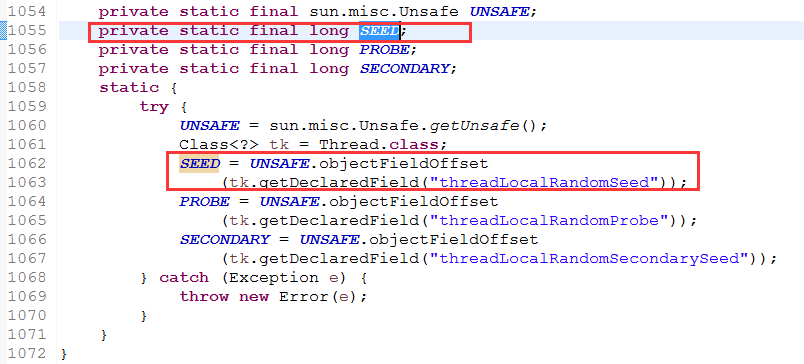概述
java.util.random可以產(chǎn)生int、long、float、double以及goussian等類型的隨機(jī)數(shù)。這也是它與java.lang.math中的方法random()最大的不同之處,后者只產(chǎn)生double型的隨機(jī)數(shù)。
該類的實(shí)例被用于生成偽隨機(jī)數(shù)的流。該類使用一個(gè) 48 位的種子,它被一個(gè)線性同余公式所修改。如果 random 的兩個(gè)實(shí)例用同一種子創(chuàng)建,對每個(gè)實(shí)例完成同方法調(diào)用序列它們將生成和返回相同的數(shù)序列成同一方法調(diào)用序列,它們將生成和返回相同的數(shù)序列。
示例
|
1
2
3
4
5
6
7
8
9
10
11
12
13
14
15
16
17
|
public class randomtest { public static void main(string[] args) { testrandom(); system.out.println("---------------------"); testrandom(); system.out.println("---------------------"); testrandom(); } public static void testrandom(){ random random = new random(1); for(int i=0; i<5; i++){ system.out.print(random.nextint()+"\t"); } system.out.println(""); }} |
輸出結(jié)果:

從結(jié)果中發(fā)現(xiàn),只要種子一樣,獲取的隨機(jī)數(shù)的序列就是一致的。是一種偽隨機(jī)數(shù)的實(shí)現(xiàn),而不是真正的隨機(jī)數(shù)。
random 源碼分析
random 類結(jié)構(gòu)
|
1
2
3
4
5
6
7
|
class random implements java.io.serializable { private final atomiclong seed; private static final long multiplier = 0x5deece66dl; private static final long addend = 0xbl; private static final long mask = (1l << 48) - 1; private static final atomiclong seeduniquifier = new atomiclong(8682522807148012l); |
有參構(gòu)造方法
|
1
2
3
4
5
6
7
8
9
10
11
12
13
|
public random(long seed) { if (getclass() == random.class) this.seed = new atomiclong(initialscramble(seed)); else { // subclass might have overriden setseed this.seed = new atomiclong(); setseed(seed); }}private static long initialscramble(long seed) { return (seed ^ multiplier) & mask;} |
通過傳入一個(gè)種子,來生成隨機(jī)數(shù),通過上面的例子發(fā)現(xiàn),種子一樣產(chǎn)生的隨機(jī)數(shù)序列一樣,如果每次使用想產(chǎn)生不一樣的序列,那就只能每次傳入一個(gè)不一樣的種子。
無參構(gòu)造方法
|
1
2
3
4
5
6
7
8
9
10
11
12
13
|
public random() { this(seeduniquifier() ^ system.nanotime()); }private static long seeduniquifier() { // l'ecuyer, "tables of linear congruential generators of // different sizes and good lattice structure", 1999 for (;;) { long current = seeduniquifier.get(); long next = current * 181783497276652981l; if (seeduniquifier.compareandset(current, next)) return next; }} |
通過源碼發(fā)現(xiàn),無參的構(gòu)造方法,里面幫我們自動(dòng)產(chǎn)生了一個(gè)種子,并通過cas自旋方式保證,每次獲取的種子不一樣,從而保證每次new random()獲取的隨機(jī)序列不一致。
nextint() 方法:獲取 int 隨機(jī)數(shù)
|
1
2
3
4
5
6
7
8
9
10
11
12
13
|
public int nextint() { return next(32);}protected int next(int bits) { long oldseed, nextseed; atomiclong seed = this.seed; do { oldseed = seed.get(); nextseed = (oldseed * multiplier + addend) & mask; } while (!seed.compareandset(oldseed, nextseed)); return (int)(nextseed >>> (48 - bits));} |
從代碼中我們可以發(fā)現(xiàn),只要種子確定后,每次產(chǎn)生的數(shù),都是采用固定的算法進(jìn)行產(chǎn)生的,所以只要種子確定后,每次產(chǎn)生的序列就是固定的。
每次更新種子的時(shí)候是使用的cas來更新的,如果高并發(fā)的環(huán)境下,性能是個(gè)問題。
安全性問題
試想下,如果這是一個(gè)搖獎(jiǎng)平臺,只要種子確定后,每次產(chǎn)生的序列都一樣。這樣就可利用這個(gè)漏洞來預(yù)測下一次開獎(jiǎng)的號碼,這樣容易被一些人鉆空子。
jdk建議大家盡量要使用 securerandom 來實(shí)現(xiàn)隨機(jī)數(shù)的生成。
securerandom
securerandom是強(qiáng)隨機(jī)數(shù)生成器,主要應(yīng)用的場景為:用于安全目的的數(shù)據(jù)數(shù),例如生成秘鑰或者會話標(biāo)示(session id),在上文《偽隨機(jī)數(shù)安全性》中,已經(jīng)給大家揭露了弱隨機(jī)數(shù)生成器的安全問題,而使用securerandom這樣的強(qiáng)隨機(jī)數(shù)生成器將會極大的降低出問題的風(fēng)險(xiǎn)。
產(chǎn)生高強(qiáng)度的隨機(jī)數(shù),有兩個(gè)重要的因素:種子和算法。算法是可以有很多的,通常如何選擇種子是非常關(guān)鍵的因素。 如random,它的種子是system.currenttimemillis(),所以它的隨機(jī)數(shù)都是可預(yù)測的, 是弱偽隨機(jī)數(shù)。
強(qiáng)偽隨機(jī)數(shù)的生成思路:收集計(jì)算機(jī)的各種信息,鍵盤輸入時(shí)間,內(nèi)存使用狀態(tài),硬盤空閑空間,io延時(shí),進(jìn)程數(shù)量,線程數(shù)量等信息,cpu時(shí)鐘,來得到一個(gè)近似隨機(jī)的種子,主要是達(dá)到不可預(yù)測性。
說的簡單點(diǎn)就是,使用加密算法生成很長的一個(gè)隨機(jī)種子,讓你無法猜測出種子,也就無法推導(dǎo)出隨機(jī)序列數(shù)。
random性能問題
從 random 源碼中我們發(fā)現(xiàn),每次獲取隨機(jī)數(shù)的時(shí)候都是使用cas的方式進(jìn)行更新種子的值。這樣在高并發(fā)的環(huán)境中會存在大量的cas重試,導(dǎo)致性能下降。這時(shí)建議大家使用threadlocalrandom類來實(shí)現(xiàn)隨機(jī)數(shù)的生成。
threadlocalrandom 實(shí)現(xiàn)原理
thread 類

thread 類中有一個(gè) threadlocalrandomseed 屬性。
threadlocalrandom 結(jié)構(gòu)

seed 變量是 threadlocalrandomseed 在 thread 對象中的偏移量。
threadlocalrandom.nextseed() 方法

從這個(gè)方法中,我們發(fā)現(xiàn),每個(gè)線程的種子值都存儲在thread對象的threadlocalrandomseed 屬性中。
結(jié)論
因?yàn)閠hreadlocalrandom 中的種子存儲在thread對象中,所以高并發(fā)獲取random對象時(shí),不會使用cas來保證每次獲取的值不一致。
每個(gè)線程維護(hù)一個(gè)它自己的種子,每個(gè)線程需要獲取隨機(jī)數(shù)的時(shí)候,從當(dāng)前的thread對象中獲取當(dāng)前線程的種子,進(jìn)行獲取隨機(jī)數(shù),性能大大提高。
好了,以上就是這篇文章的全部內(nèi)容了,希望本文的內(nèi)容對大家的學(xué)習(xí)或者工作能帶來一定的幫助,如果有疑問大家可以留言交流,謝謝大家對服務(wù)器之家的支持。
原文鏈接:http://www.jianshu.com/p/ab0c15c6dd99















